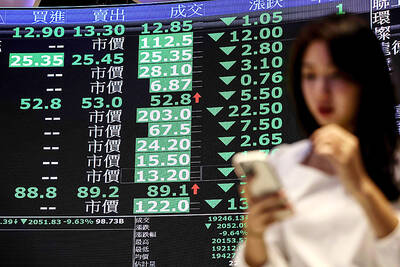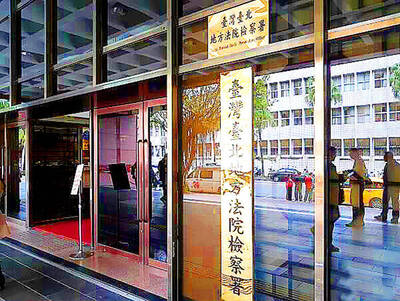The latest computerized scenario carried out by the military showed that in a war with China, Taipei would be occupied by enemy forces in just three days, a magazine report said yesterday.
Last month’s simulation, attended by President Ma Ying-jeou (馬英九), came amid warnings that China was expected to increase the number of its missiles aimed at Taiwan by several hundred to more than 1,900 by the end of this year. These include ballistic missiles, cruise missiles and other weaponry deployed throughout China.
Under the scenario, which assumed war at next year’s force levels, the People’s Liberation Army (PLA) launched intensive air raids on Taiwan before sending in ground troops from the sea and air, the Chinese-language Next Magazine reported.
The drill found that Chinese troops could march into Taipei on the third day of hostilities, seizing control of top military command facilities and the Presidential Office, Next said, quoting unnamed sources.
The results were a severe blow to Ma’s goal of building “solid defense and efficient deterrence” with a small but elite army, the magazine said.
During his presidential campaign, Ma vowed to build a stronger military as a deterrent against aggression by Beijing. Under Ma’s plan, Taipei has worked to achieve an all-volunteer force, but this will come at great cost to the defense budget, which is set at US$9.3 billion this year, a 6.9 percent drop from last year’s US$9.6 billion and US$10.5 billion in 2008.
The military must also cope with a number of aging defense systems that are due for refurbishing or replacement, including its F-16A/B fighter aircraft.
The Ministry of National Defense dismissed Next’s report.
The conclusion to this year’s scenario would be a dramatic departure from the computer simulation segment of the Han Kuang exercises held in June last year, in which, after seeing the air force and navy annihilated by PLA forces, reorganized army forces managed to mop up the eight divisions of Chinese soldiers that landed in the southern, central and northern parts of the country.
Last year’s scenario also did not factor in the possibility of decapitation attacks by the PLA, which had figured, albeit controversially, in previous years’ exercises.
Since Ma took office, the live-fire exercises accompanying the computer simulations have been canceled or downsized, which many have seen as a concession to rapprochement efforts. The military has also been instructed to prepare for humanitarian assistance and natural disasters over the possibility of a Chinese invasion.
In recent years, defense analysts have raised the specter of a shift in the balance of power in the Taiwan Strait, fears that stem from the US’ reluctance to sell Taipei advanced weaponry and years of double-digit growth in the declared PLA annual military budget. Recent reports conclude that the balance has now shifted in Beijing’s favor.
Under US-Taiwan security pacts, Taiwan’s military would be expected to hold off a Chinese invasion for 10 days to two weeks before US forces could intervene.

Intelligence agents have recorded 510,000 instances of “controversial information” being spread online by the Chinese Communist Party (CCP) so far this year, the National Security Bureau (NSB) said in a report yesterday, as it warned of artificial intelligence (AI) being employed to generate destabilizing misinformation. The bureau submitted a written report to the Legislative Yuan in preparation for National Security Bureau Director-General Tsai Ming-yen’s (蔡明彥) appearance before the Foreign Affairs and National Defense Committee today. The CCP has been using cognitive warfare to divide Taiwanese society by commenting on controversial issues such as Taiwan Semiconductor Manufacturing Co’s (TSMC, 台積電) investments in the

HELPING HAND: The steering committee of the National Stabilization Fund is expected to hold a meeting to discuss how and when to utilize the fund to help buffer the sell-off The TAIEX plunged 2,065.87 points, or 9.7 percent, to close at 19,232.35 yesterday, the highest single-day percentage loss on record, as investors braced for US President Donald Trump’s tariffs after an extended holiday weekend. Amid the pessimistic atmosphere, 945 listed companies led by large-cap stocks — including Taiwan Semiconductor Manufacturing Co (TSMC, 台積電), Hon Hai Precision Industry Co (鴻海精密) and Largan Precision Co (大立光) — fell by the daily maximum of 10 percent at the close, Taiwan Stock Exchange data showed. The number of listed companies ending limit-down set a new record, the exchange said. The TAIEX plunged by daily maxiumu in just

INVESTIGATION: The case is the latest instance of a DPP figure being implicated in an espionage network accused of allegedly leaking information to Chinese intelligence Democratic Progressive Party (DPP) member Ho Jen-chieh (何仁傑) was detained and held incommunicado yesterday on suspicion of spying for China during his tenure as assistant to then-minister of foreign affairs Joseph Wu (吳釗燮). The Taipei District Prosecutors’ Office said Ho was implicated during its investigation into alleged spying activities by former Presidential Office consultant Wu Shang-yu (吳尚雨). Prosecutors said there is reason to believe Ho breached the National Security Act (國家安全法) by leaking classified Ministry of Foreign Affairs information to Chinese intelligence. Following interrogation, prosecutors petitioned the Taipei District Court to detain Ho, citing concerns over potential collusion or tampering of evidence. The

‘COMPREHENSIVE PLAN’: Lin Chia-lung said that the government was ready to talk about a variety of issues, including investment in and purchases from the US The National Stabilization Fund (NSF) yesterday announced that it would step in to staunch stock market losses for the ninth time in the nation’s history. An NSF board meeting, originally scheduled for Monday next week, was moved to yesterday after stocks plummeted in the wake of US President Donald Trump’s announcement of 32 percent tariffs on Taiwan on Wednesday last week. Board members voted to support the stock market with the NT$500 billion (US$15.15 billion) fund, with injections of funds to begin as soon as today. The NSF in 2000 injected NT$120 billion to stabilize stocks, the most ever. The lowest amount it